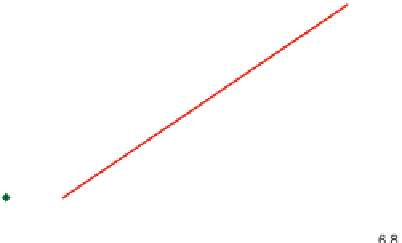Biomedical Engineering Reference
In-Depth Information
Equilibrium deflection versus pH for increasing pH (solid symbols) and decreasing pH (open
symbols) at constant ionic strength (0.5 M). The solid line is a linear fit. Adapted with permission
from Hilt et al.(
2003
) © 2003 Springer.
Figure 11.7
11.2
Food and cosmetic applications
The truly innovative work in this area tends to be limited by statutory requirements. That
said, as far as food applications are concerned, the major new potential use of physical
gels is in low-calorie products. We stress
since, starting in the 1980s, the food
patent literature seems large but the number of real low-calorie products based on gels
appears limited. The principle of this
'
potential
'
approach is quite sound. Taking
the case of full-fat (c.80%) spreads such as butter and margarine, if the solid fat is
removed from a product, something else is needed to maintain its solid character, and a
gelling biopolymer component appears to be very appropriate. Unfortunately there are
problems. First, the taste and
'
materials science
'
of some polysaccharide gels are not attractive.
Here gelatin has a number of advantages: it has little
'
mouth-feel
'
around body (i.e.
mouth) temperature. However, there are ethical issues in using mammalian gelatin,
particularly for vegetarians. There is less of a problem with piscine gelatins, but, as
noted in
Chapter 7
, these generally melt at lower temperatures. The external literature
includes a number of proposals, including work by Kasapis and co-workers
(Roberts et al., 2000) on the respective binary systems of starch, caseinate (from milk)
and alginate. By changing the compositions, and the concentration of added Ca
2+
, they
claim to have matched at least some of the mechanical properties of traditional spreads.
More recently, Cheng and co-workers (Cheng et al.,
2008
) have used a mixed gel of
piscine gelatin and pectin, and prepared model
avour and
'
melts
'
'
zero-fat
'
spread systems with rheological
properties that begin to mimic those of fat spreads.
In Japan and elsewhere in the Far East there is an extended culture of food gels,
particularly from polysaccharides (Nishinari,
1988
). More novel applications include
arti
cial salmon roe (widely used as an important ingredient in sushi), made from salad
oil and seaweed extract, with the
made from carrageenan or sodium alginate,
again gelled by the addition of Ca
2+
. Apparently its appearance, texture and taste cannot
'
skin
'





































































Search WWH ::

Custom Search